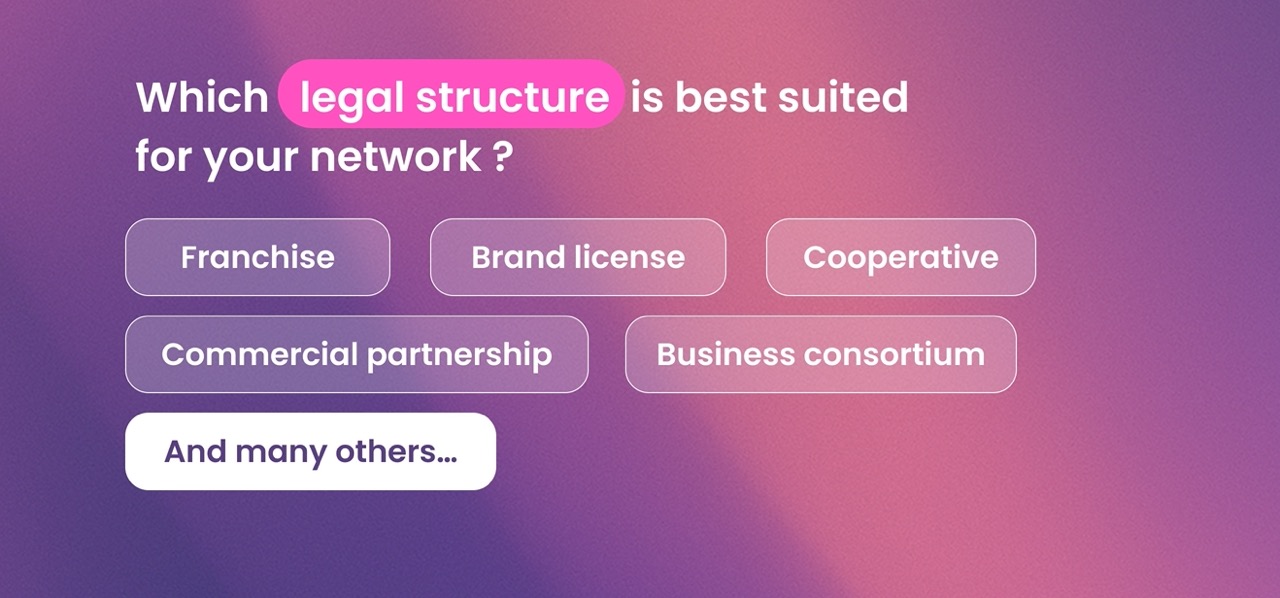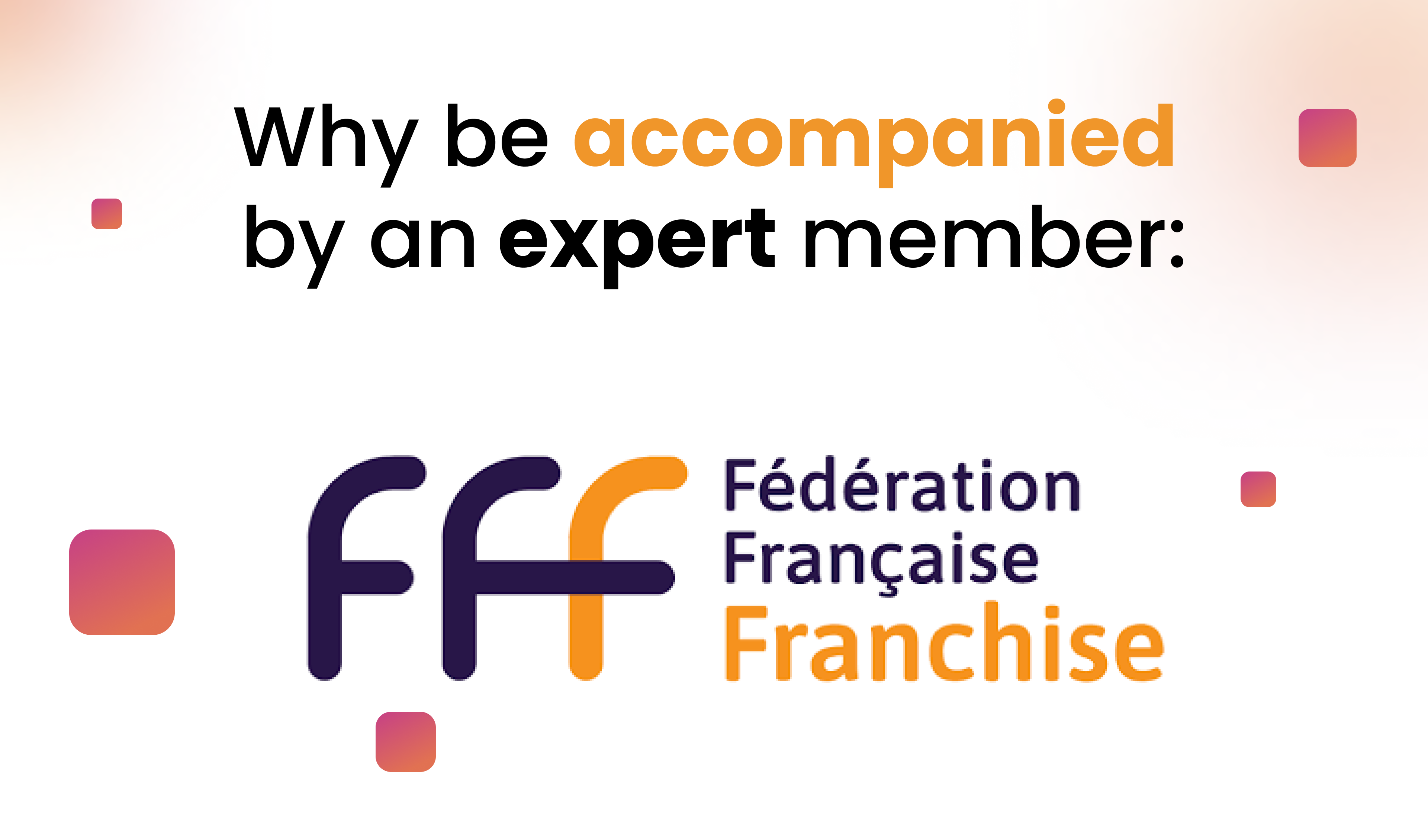Introduction
Which legal structure is best to create a commercial network? Should you opt for franchising or another model? How do you scale your network without losing control or efficiency? Is there an ideal legal framework that balances rapid growth with member autonomy?
If you’re asking yourself these questions, you’re in the right place!
Choosing your company’s legal structure is a decisive step in building a high-performing brand network. But beware: even with the same model, results can vary widely if the network is poorly managed.
Because whatever structure you choose, one thing is certain: effective management is the key to success.
In this article, we share examples of legal structures for your company.
Understanding the main legal structures for a network

Franchising: a structured model to grow fast
Among the different company legal options to develop a network, franchising remains one of the most widespread and powerful models for rapid growth.
Franchising is based on a commercial contract in which a company (the franchisor) grants a third party (the franchisee) the right to operate its brand, concept, and know-how. In return, the franchisee agrees to follow a defined framework and pay fees.
Advantages of this legal model for your network:
- Rapid expansion via financially autonomous franchisees
- Shared risk and investment between franchisor and franchisees
- Structured transfer of know-how, often formalized in manuals or training
- A proven model validated by a pilot store
Drawbacks to anticipate:
- Complex setup requiring robust contracts, an operating manual, and clear communication to franchisees
- Risk of brand image deterioration if standards aren’t properly understood, shared, or applied in the field
👉 This is precisely why Seenaps designed its “Train & Engage” module (original: Former & Engager).
It lets you centralize all key resources (manuals, brand identity, e-learning materials, procedures) in a space accessible to every member of the network. The result:
- Smoother roll-outs
- Consistent transfer of know-how
- Lasting alignment with your brand and values
Trademark licensing: simplicity first
Among the legal options to build a network, trademark licensing stands out for its simplicity. It authorizes a company (the licensee) to use a brand for a fee, without formally transferring know-how. It’s a lighter model, often chosen to kick-start rapid development without the structuring obligations of franchising.
Strengths of this model:
- Quick to set up with fewer contractual constraints
- Fewer responsibilities for the licensor, who retains a limited role
- Ideal for testing a concept before moving to a more governed model like franchising
But this flexibility has a flip side:
- Limited operational control in the field
- A loose network where engagement, quality, or consistency can quickly erode
👉 Chosen this model but want to keep a strong connection with your network?
The Seenaps “Coach & Support” module (original: Animer & Accompagner) is built to strengthen field support quality, even in lighter structures like licensing.
- Smart scheduling of network visits
- Custom visit reports
- Precise evaluations with built-in audits
- Real-time tracking of performance and areas for improvement
With Seenaps, make the work of area managers, field coordinators, or regional leads easier—and reinforce network consistency without adding structural weight.
Cooperatives: pooling resources and collective commitment
Among company legal forms used to structure a network, the cooperative is unique. It’s built on a core principle: members are both users of the network (retailers, artisans, farmers, etc.) and participants in its governance through a democratic, participatory organization.
Major advantages of this model:
- Fair sharing of profits and responsibilities
- Strong member involvement, invested in collective success
- A structure often aligned with ethical, sustainable values that mobilize people
Limits to consider:
- Slower decision-making due to collegiate governance
- Often limited capital, constrained by members’ contribution capacity
👉 Leading or advising a cooperative network?
Seenaps helps you run this complex organization effectively by providing clear strategic visibility, unified performance tracking, and analysis tools suited to shared governance.
With our “Pilot Strategically” module (original: Pilotez stratégiquement), align decisions with on-the-ground realities, rally members around shared goals, and scale your network in a controlled way.
Comparing legal forms based on your goals
Choosing the right legal structure for your network isn’t just an administrative decision. It’s a strategic choice that should reflect your growth objectives, company culture, and investment capacity. Here are some guides to shape your thinking.
Rapid growth or progressive structuring?
Some legal forms are designed to accelerate growth; others emphasize a more collaborative, durable build.
- Franchise and trademark license: formats designed for rapid roll-out, often managed remotely from a central HQ. Ideal for quickly establishing presence with autonomous operational relays.
- Cooperative, partnership, or business grouping: models that prioritize progress through collaboration, co-construction, and steadily deepening engagement.
Brand control or member autonomy?
The level of control you want is a key criterion when choosing your company’s legal structure.
- Franchise: maximum control over brand, processes, and commercial practices.
- Trademark license: greater freedom for the licensee, with less operational involvement.
- Cooperative: decisions made collectively, with necessary compromise.
👉 Centralize steering—even in hybrid models. Seenaps adapts to every type of network: franchisees, licensees, cooperative members, partners, affiliates…
Long-term vision and initial investment
Lastly, durability and available resources should guide your choice.
- Franchise and cooperative: heavier to set up, but offering long-term stability and resilience.
- License or partnership: lighter, more accessible options to start, but often requiring structural readjustment over time.
- Business grouping: a compelling balance between local autonomy and collective strength, suited to networks that want to pool resources without merging.
Other company legal forms to consider
Beyond the best-known models, several company legal structures can suit more flexible or collaborative development strategies. These are often chosen for their flexibility or pooling logic.
Commercial partnership: for greater flexibility
A commercial partnership is a contractual agreement between two entities (company, brand, store, etc.) to cooperate temporarily or long term on the commercial front. It’s often used to test a geographic area, launch a joint offer, or build strategic ties without formalizing a full network structure.
Advantages:
- Simple operations and quick to implement
- Broad contractual freedom without heavy legal burdens
Limits:
- Legal gray areas in case of dispute or misunderstanding
- Low structuring, which can harm overall network coherence
👉 Multiplying local or regional partnerships?
With Seenaps, you keep control over communication, data, and coordination across your network.
Business grouping: an alliance of independents
A business grouping allows legally independent entities to pool certain resources to improve competitiveness: purchasing, communications, innovation, shared services, and more.
Benefits of this model:
- Cost reduction through pooling
- Preservation of each member’s legal and operational autonomy
This legal structure is especially well-suited to networks seeking to combine collective synergy with individual freedom.
👉 Leading a grouping of autonomous actors?
Seenaps helps you synchronize actions, pool resources, and steer results.
Explore all possible forms
Beyond franchising, partnerships, or groupings, other company legal structures may fit your project:
- GIE (Economic Interest Grouping)
- SCIC (Collective-Interest Cooperative Company)
- Network SAS, or hybrid contractual forms, etc.
👉 Whatever your network model (franchise, license, grouping, partnership…), Seenaps helps you structure, activate, and grow your network every day.
Whatever the legal form, success depends on management
No solid network without the right tools
Whatever company legal structure you choose—franchise, license, cooperative, grouping, or partnership—one fact stands out: a network without proper steering is a network that runs out of steam.
The most common symptoms:
- Difficulty spreading best practices to all members
- Loss of alignment on values, goals, or standards
- Poor visibility into network performance and areas for improvement
Seenaps, the platform to structure your network
To address these challenges, Seenaps has developed an all-in-one SaaS platform designed to support every company legal form, regardless of maturity level.
✔️ Data centralization (documents, KPIs, member profiles)
✔️ Network activation & tracking (visits, reporting, communications)
✔️ Process automation (onboarding, audit, action plan)
There is no single ideal, universal legal structure. The right choice depends on many factors: your growth ambitions, management culture, financial resources, and long-term vision.
But one point is common to all models: a network’s success rests on its ability to be structured, aligned, and well-steered.
👉 Want to see how Seenaps can transform your network management?



